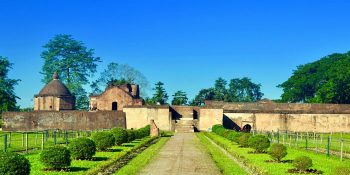Agra Fort, a magnificent citadel that has stood the test of time, epitomizes the architectural brilliance and historical significance of India. Situated in the city of Agra, Uttar Pradesh, this colossal fortress stands as a testament to the power and opulence of the Mughal Empire. Spanning over 94 acres, Agra Fort is not merely a structure but a symbol of India’s rich cultural heritage and architectural prowess.
Constructed primarily of red sandstone, Agra Fort bears the hallmark of Mughal architectural style, characterized by intricate carvings, majestic domes, and imposing gateways. The fort’s walls, towering up to 70 feet in height, encircle within them a plethora of palaces, mosques, gardens, and audience halls, each narrating a story of grandeur and splendor.
One of the most striking features of Agra Fort is its imposing entrance, known as the Amar Singh Gate. As visitors pass through this monumental gateway, they are greeted by a sense of awe and reverence, as if stepping into a realm frozen in time. The gate’s intricate carvings and towering archways serve as a prelude to the architectural marvels that lie within.
Walking through the labyrinthine pathways of Agra Fort, one encounters a myriad of structures, each more breathtaking than the last. The Jahangiri Mahal, built by Emperor Akbar in the 16th century, is a stunning example of Mughal architecture, with its intricate lattice work, ornate balconies, and spacious courtyards. It is said that this palace was once the residence of Akbar’s beloved queen, Jodha Bai, adding a layer of romance to its already enchanting aura.
Adjacent to the Jahangiri Mahal stands the Diwan-i-Khas, or Hall of Private Audience, where the emperor would hold intimate gatherings with his trusted advisors and dignitaries. This exquisite hall is adorned with intricately carved pillars and a magnificent throne, symbolizing the emperor’s authority and grandeur.
As one delves deeper into the heart of Agra Fort, they come across the iconic Moti Masjid, or Pearl Mosque, a pristine white marble structure that exudes tranquility and serenity. Built by Emperor Shah Jahan, the mosque stands as a testament to his devotion to Islam and his passion for architectural perfection.
The crown jewel of Agra Fort is undoubtedly the Shah Burj, a majestic marble pavilion located on the northeastern corner of the fortress. From here, Emperor Shah Jahan, during his captivity, would gaze longingly at the Taj Mahal, a monument he had built in memory of his beloved wife, Mumtaz Mahal. The Shah Burj thus serves as a poignant reminder of love, loss, and the enduring legacy of the Mughal Empire.
Beyond its architectural splendor, Agra Fort holds a wealth of historical significance, having served as a seat of power for successive Mughal emperors and witnessing countless triumphs and tragedies throughout its storied past. From the reign of Akbar the Great to the tumultuous days of Shah Jahan’s imprisonment, Agra Fort has borne witness to the rise and fall of empires, making it a living testament to India’s rich and diverse history.
In conclusion, Agra Fort stands as a timeless monument to India’s architectural grandeur and historical legacy. From its imposing walls to its intricately adorned palaces, every stone of this magnificent fortress tells a story of emperors and empires, love and loss, triumph and tragedy. As visitors wander through its hallowed halls, they cannot help but be transported back in time, to an era of opulence and splendor that continues to captivate the imagination to this day.









